Spring Cleaning! How to Clear Out the Medicine Cabinet So You Actually Know Where Things Are
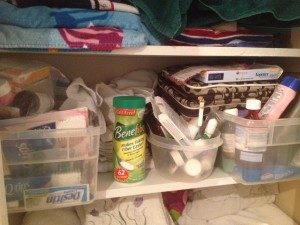
We had a pretty ridiculous practice in our house. When one of our kids got sick (or we got sick ourselves…usually because they were sick), we went out to the drug store and got whatever we needed to help that person feel better. While on face value that might sounds completely normal and reasonable, the truth is that we already had all the stuff we needed. We just didn’t know where to find it!
To say Spring Cleaning and getting organized was necessary is a real understatement. What a mess! As you can see, everything was dumped into containers and shoved in our linen closet and in random places around the house. Cough medicine, band-aids, Pepto-bismol, extra bottles of pain reliever and the kids medicines were swimming together in a sea of anarchy. There was no rhyme or reason to the madness.
It was time to do something about it. I figure, perhaps I’m not the only one who had this problem—and if I am, let this article serve as a reminder to myself of what was and how things should be!
(1) Gather it all together: Get everything that’s considered medicine or treatment for ailments in one place. Go into every medicine cabinet and take out the pill bottles you haven’t even looked at in years. Rescue the Band-aids from the bottom of the closet and the Neosporin from whomever’s room where you used it last. Now, dump it out on the floor or on the table so you can see everything.
 (2) Check for dates: Go through every pill and medicine bottle and check for the expiration dates. You may be surprised. Well, maybe not surprised but perhaps a little concerned or embarrassed. Whoops! Here’s one pill bottle I found from 2008—yup, I think that one’s a goner. Um…dispose of those!
(2) Check for dates: Go through every pill and medicine bottle and check for the expiration dates. You may be surprised. Well, maybe not surprised but perhaps a little concerned or embarrassed. Whoops! Here’s one pill bottle I found from 2008—yup, I think that one’s a goner. Um…dispose of those!
(3) Categorize: Put each medication or treatment into a category. For example, “Stomach pain,” “First-aid,” “Cold & Flu,” “Ears, Eyes, & Throat,” and “Muscle soreness.” You can have a miscellaneous if you don’t know where it fits.
(4) Box it up: Put the medications and treatments in clear drawers or clear boxes based on the categories you made. Place it in neatly so you 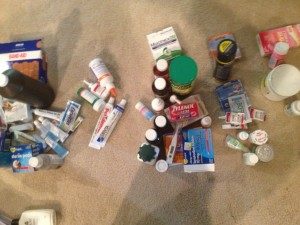 don’t have to rummage through everything to find what you are looking for…at midnight…with the lights off. Make extra little boxes to keep elsewhere if you often use certain things very often in a separate area of your home. For example, I made a “Boo Boo Box” because, well, I have 2 young kids who run into things a lot. And I also made a box for all of my daughter’s hair ties and accessories—it was one of the most exciting parts of this process. I don’t know how to explain how good it feels to have all that stuff in one place instead of all over my house. Someone reading this will understand—others will likely think I’m nuts.
don’t have to rummage through everything to find what you are looking for…at midnight…with the lights off. Make extra little boxes to keep elsewhere if you often use certain things very often in a separate area of your home. For example, I made a “Boo Boo Box” because, well, I have 2 young kids who run into things a lot. And I also made a box for all of my daughter’s hair ties and accessories—it was one of the most exciting parts of this process. I don’t know how to explain how good it feels to have all that stuff in one place instead of all over my house. Someone reading this will understand—others will likely think I’m nuts.
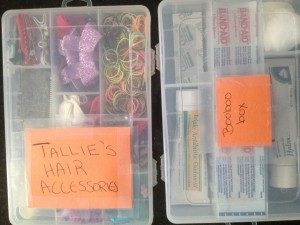
(5) Label it: If you have a label machine, by all means, use it! If you don’t, just write out what’s in the box on card stock, construction paper, or mailing labels.
(6) Place it in the closet and marvel: Wow. Did you know you had that much space? I know. The question is looming; why didn’t you do this sooner? That was knocking around in my brain too. Forget that. You did it! How cool are you?
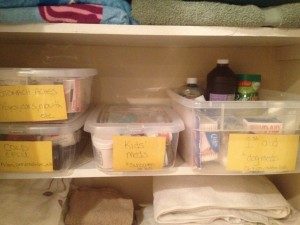
It was a little odd, but I was actually couldn’t wait until someone needed something. A little nerdy of me– but hey, I knew where it was! Stomach pain? Here you go! Lozenges? Back in a flash! Of course, with a young family, I didn’t have to wait long. And that boo boo box certainly has gotten a work out already.
Good luck to you!

Spring Cleaning! How to Clear Out the Medicine Cabinet So You Actually Know Where Things Are is a post from: Dr. Robyn Silverman – Child Development Specialist, Body Image Expert, Success Coach & the Creator of the Powerful Words Character Development System

 I can’t believe I’m saying this…Parents are forgetting their kids at the children’s play place, Chuck E. Cheese’s. While this may sounds like the makings of a Saturday Night Live skit to you, it’s actually the truth. Yesterday, Good Morning America called me to do a piece (which was squashed at the final hour) about a 5 year old girl who was left at Chuck E. Cheese’s last week.
I can’t believe I’m saying this…Parents are forgetting their kids at the children’s play place, Chuck E. Cheese’s. While this may sounds like the makings of a Saturday Night Live skit to you, it’s actually the truth. Yesterday, Good Morning America called me to do a piece (which was squashed at the final hour) about a 5 year old girl who was left at Chuck E. Cheese’s last week.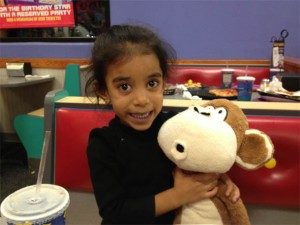 But, believe it or not, this has happened before to other parents. In fact, it just happened last Monday to another family!
But, believe it or not, this has happened before to other parents. In fact, it just happened last Monday to another family!